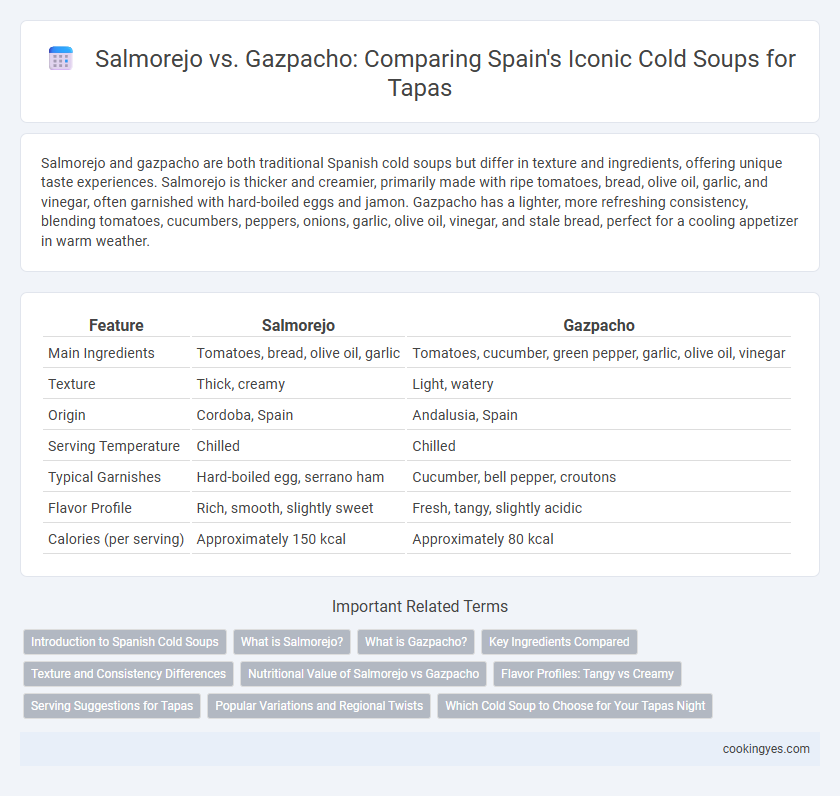Salmorejo and gazpacho are both traditional Spanish cold soups but differ in texture and ingredients, offering unique taste experiences. Salmorejo is thicker and creamier, primarily made with ripe tomatoes, bread, olive oil, garlic, and vinegar, often garnished with hard-boiled eggs and jamon. Gazpacho has a lighter, more refreshing consistency, blending tomatoes, cucumbers, peppers, onions, garlic, olive oil, vinegar, and stale bread, perfect for a cooling appetizer in warm weather.
Table of Comparison
| Feature | Salmorejo | Gazpacho |
|---|---|---|
| Main Ingredients | Tomatoes, bread, olive oil, garlic | Tomatoes, cucumber, green pepper, garlic, olive oil, vinegar |
| Texture | Thick, creamy | Light, watery |
| Origin | Cordoba, Spain | Andalusia, Spain |
| Serving Temperature | Chilled | Chilled |
| Typical Garnishes | Hard-boiled egg, serrano ham | Cucumber, bell pepper, croutons |
| Flavor Profile | Rich, smooth, slightly sweet | Fresh, tangy, slightly acidic |
| Calories (per serving) | Approximately 150 kcal | Approximately 80 kcal |
Introduction to Spanish Cold Soups
Salmorejo and gazpacho are iconic Spanish cold soups originating from Andalusia, renowned for their refreshing qualities during hot summers. Salmorejo features a thicker, creamier texture made from ripe tomatoes, bread, garlic, and olive oil, while gazpacho is lighter and more liquid, incorporating cucumbers, peppers, and vinegar. Both dishes showcase the vibrant flavors of Spanish cuisine and highlight regional variations in cold soup preparation.
What is Salmorejo?
Salmorejo is a traditional Spanish cold soup originating from Cordoba, made primarily with ripe tomatoes, bread, garlic, olive oil, and vinegar, resulting in a thick, creamy texture. Unlike gazpacho, which is more liquid and includes a variety of vegetables like cucumbers and peppers, salmorejo emphasizes a rich, smooth consistency and garnishes such as hard-boiled eggs and jamon iberico. This dish embodies the essence of Andalusian cuisine, offering a concentrated tomato flavor that is both refreshing and satisfying during hot weather.
What is Gazpacho?
Gazpacho is a traditional Spanish cold soup originating from Andalusia, made primarily with ripe tomatoes, cucumbers, bell peppers, garlic, olive oil, vinegar, and stale bread, blended into a refreshing, smooth consistency. It is renowned for its bright, tangy flavor profile and served chilled, making it ideal for hot summer days. Unlike Salmorejo, Gazpacho typically includes a broader variety of vegetables and has a thinner, more liquid texture.
Key Ingredients Compared
Salmorejo and gazpacho are classic Spanish cold soups that share tomatoes as a primary ingredient but differ significantly in texture and additional components. Salmorejo features a thicker consistency due to a higher proportion of bread and olive oil, creating a creamy base often garnished with hard-boiled eggs and jamon serrano. Gazpacho incorporates cucumber, green bell peppers, garlic, and vinegar, resulting in a lighter, more refreshing soup with a tangy and slightly acidic flavor profile.
Texture and Consistency Differences
Salmorejo features a thick, creamy texture achieved through blending ripe tomatoes with bread and olive oil, resulting in a rich, velvety consistency ideal for dipping or drizzling toppings. Gazpacho has a thinner, more liquid consistency, combining fresh vegetables like cucumber, green pepper, and tomato with vinegar for a refreshing, slightly chunky soup perfect for sipping. The contrast in texture makes salmorejo more filling and substantial, while gazpacho offers a lighter, more hydrating option among cold soups.
Nutritional Value of Salmorejo vs Gazpacho
Salmorejo contains higher levels of healthy fats and calories due to its olive oil and bread base, making it a richer source of energy compared to the lighter, more hydrating gazpacho that emphasizes fresh vegetables like cucumber and tomato. Gazpacho offers a lower fat content and more vitamin C per serving, promoting better hydration and antioxidant benefits, while salmorejo provides more fiber and vitamin E. Both cold soups are nutrient-dense, but salmorejo's composition supports sustained energy, whereas gazpacho excels in delivering essential vitamins with fewer calories.
Flavor Profiles: Tangy vs Creamy
Salmorejo offers a creamy, rich texture marked by the smooth blend of ripe tomatoes, olive oil, and bread, delivering a velvety mouthfeel with subtle garlic undertones. Gazpacho features a tangy, refreshing flavor profile, combining fresh cucumbers, bell peppers, vinegar, and raw tomatoes for a bright and zesty experience. Both traditional Spanish cold soups showcase distinct taste sensations: salmorejo's creaminess contrasts with gazpacho's invigorating acidity.
Serving Suggestions for Tapas
Salmorejo is a thick, creamy cold soup made from tomatoes, bread, garlic, and olive oil, traditionally served with toppings like hard-boiled eggs and cured ham, perfect for tapas as a rich and savory option. Gazpacho, a lighter cold soup blending tomatoes, cucumbers, peppers, and vinegar, offers a refreshing and tangy flavor profile, making it ideal for refreshing palate cleansers or pairing with seafood tapas. Both soups complement tapas by providing contrasting textures and flavors, enhancing the overall dining experience with either a hearty or zesty bite.
Popular Variations and Regional Twists
Salmorejo, a creamy cold tomato soup from Cordoba, is typically thicker and richer than the lighter, more liquidy gazpacho, which hails from Andalusia as well. Popular variations of salmorejo include toppings like hard-boiled eggs and jamon serrano, while gazpacho often incorporates cucumbers, bell peppers, and garlic for a fresher, tangier profile. Regional twists influence gazpacho's ingredients--such as the ajout of bread in Granada's version or the inclusion of fruit like watermelon in Extremadura--highlighting the diverse culinary traditions across southern Spain.
Which Cold Soup to Choose for Your Tapas Night
Salmorejo features a thicker texture and creamier taste due to its blend of ripe tomatoes, bread, garlic, and olive oil, making it an ideal choice for a rich, flavorful tapas night. Gazpacho offers a lighter, refreshing option with a mixture of raw vegetables like tomatoes, cucumbers, peppers, and onions, perfect for cleansing the palate between diverse tapas dishes. Choosing between salmorejo and gazpacho depends on whether you prefer a hearty, velvety soup or a crisp, zesty starter to complement your selection of tapas.
Salmorejo vs Gazpacho for cold soups Infographic

 cookingyes.com
cookingyes.com